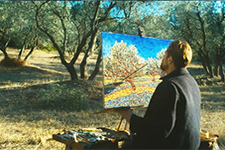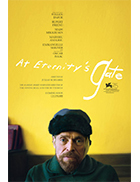At Eternity's Gate
|  Julian Schnabel’s At Eternity’s Gate is the painter-turned-filmmaker’s free-flowing depiction of last few years of the great post-Impressionist Dutch painter Vincent van Gogh’s life. It is quite different, in this regard, from Schnabel’s directorial debut Basquiat (1996), which was billed as the first commercial feature film about a painter directed by a painter. Despite its wide-ranging artistic license, Basquiat was a much more conventional biopic of graffiti artist Jean-Michel Basquiat, tracing his life from homeless artist to toast of the 1980s New York art world. It had a clear arc for its doomed outsider artist, which made it accessible even as Schnabel used it primarily as a vehicle to convey his own artistic obsessions. Of course, At Eternity’s Gate is also about a doomed outsider artistic—perhaps the quintessential outsider artist, the sin qua non of tortured artistic geniuses—so it’s not surprising that Schnabel would be drawn to yet another cinematic retelling of van Gogh’s life (earlier films include Vincent Minnelli’s 1956 Lust for Life and Robert Altman’s 1990 Vincent and Theo, as well as last year’s Loving Vincent, a sort-of mystery about van Gogh’s death that was animated entirely by actual oil paintings in the his style). The narrative focuses entirely on van Gogh’s final two years, most of which were spent in Arles, France, when he was churning out paintings—literally hundreds of them—at a frantic pace. When the film opens, van Gogh (Willem Dafoe) is unsuccessfully trying to build his reputation via a public show of his works at a Parisian restaurant, which is roundly rejected by the grouchy proprietor (this rejection is painful for van Gogh, but painfully ironic for us given our knowledge of how influential van Gogh would end up becoming). The majority of the film moves among impressionistic depictions of van Gogh at work with dramatic scenes of him interacting with various people in his life, particularly the gregarious French painter Paul Gauguin (Oscar Isaac); Madame Ginoux (Emmanuelle Seigner), the proprietor of the café behind which van Gogh rents a room; and his brother Theo (Rupert Friend), a businessman who supported him financially and tried to sell his paintings. Much of the film’s critical attention is revolving around Willem Dafoe’s intense performance as van Gogh, and it is consistently mesmerizing in the way he conveys the painter’s relentless internal strife, artistic ambitions, and psychological instability. Dafoe is fully three decades older than van Gogh was at this period in his life, but this discrepancy isn’t particularly distracting because Dafoe’s aged facial features, which we often see in close-up, reflect the artist’s struggle, psychologically and physically (he was known to take terrible care of himself, and at one point a character remarks on how bad he smells). It is one of those tailor-made Oscar-bait roles, as it stages a historical figure with mental illness against a backdrop of narrative abstraction that inherently makes Dafoe’s performance the center of attention, and I won’t be surprised if he wins a long overdue golden statue. For much of his career Dafoe has specialized in playing tortured souls—the soldier-martyr Sgt. Elias in Oliver Stone’s Platoon (1986), the conflicted Jesus in Martin Scorsese’s The Last Temptation of Christ (1988), even the literally split villainous Green Goblin in Sam Raimi’s Spider-Man (2002)—so portraying van Gogh, especially in his haunted later years, feels like a natural fit. To his credit, Dafoe doesn’t overplay the role, but rather emphasizes the artist’s riven internal world, his frustration with other people who don’t understand him, his deep appreciation of the world around him, and most of all his intense sadness, his grief, his sense of loss as his loses his mind. Most of Schnabel’s cinematic career has been focused on biographical films: In addition to Basquiat, he directed Before Night Falls (1998), a portrait of the Cuban poet Reinaldo Arenas, and The Diving Bell and the Butterfly (2007), his remarkable first-person depiction of editor Jean-Dominique Bauby’s experience being locked inside his own body after a paralyzing stroke. Schnabel’s style shifts from film to film, and for At Eternity’s Gate, he and French cinematographer Benoît Delhomme adopt an aesthetic approach that cinematically mirrors van Gogh’s painterly style, which famously used broad strokes, bright colors, and a rough surface texture (Gauguin at one point notes that van Gogh was as much of a sculptor as he was a painter). Schnabel dedicates lengthy sequences to simply following van Gogh as he wanders the picturesque countryside, ostensibly seeking subjects to paint (he always painted a subject he could look at) and in the best possible light, but also simply wandering in his own internal world externalized onto the landscape around him. The film is deeply beautiful in these sequences, although it is most compelling when we watch van Gogh at work painting old boots or tree roots, which allows us to really appreciate the depth of his style and how he assembled seemingly crude brush strokes into works of profound beauty. Unfortunately, the film itself lacks that sense of depth as a whole, as the screenplay by Jean-Claude Carrière, Schnabel, and Louise Kugelberg is content to work as a series of mostly isolated sequences with only vague connecting tissue. There is some dramatic development, particularly in van Gough’s increasingly tormented relationship with Gauguin (which is what causes him to infamously cut off part of his own ear), but it is never as riveting as when he is alone in his room or in the middle of a field, feverishly putting thick swathes of paint on a canvas and remaking the world in his own style. At Eternity’s Gate doesn’t reveal anything about van Gogh you probably didn’t know already, but it does convey in its own powerful way the intensity, the vitality, the sheer necessity of his artistry. Copyright © 2018 James Kendrick Thoughts? E-mail James Kendrick All images copyright © CBS Films |
Overall Rating: 

 (3)
(3)


